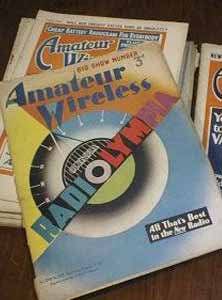
At the first National Radio Exhibition, held at Olympia in September 1926, a body was established to represent all British manufacturers - the Radio Manufacturers' Association. The RMA continued to run the show until the war, and in 1944 was reconstituted as the British Radio Equipment Manufacturers' Association (BREMA). Exhibitors totalled about 150, and included set and component manufacturers, wholesalers and trade papers. There were substantial exhibits by the Post Office and, of course, the BBC, which broadcast variety shows from a theatre built within the exhibition hall. The chance to see radio personalities no doubt contributed to the popularity of Radiolympia; attendance figures peaked at 238,000 in 1934.
Les "LG" Smith worked at Olympia during the 1936 and 1937 shows and describes the equipment used.
The BBC contribution to Radiolympia involved two entirely separate activities.
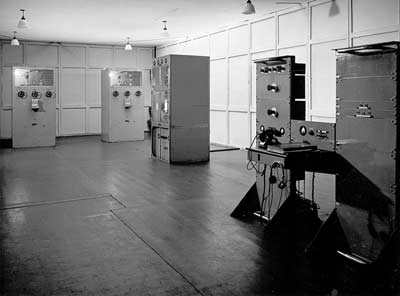
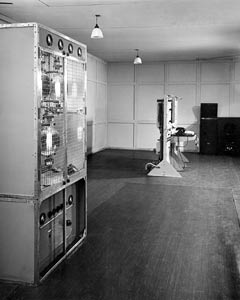
The second picture of this area looks in the opposite
direction - main power amplifier in the foreground, control desk and amps
in the background, with a monitoring speaker against the wall.
The equipment was, I believe, a duplicate of that used to feed loudspeakers on the eighth floor of Broadcasting House to broadcast Big Ben to Portland Place. I had no direct involvement in this aspect of the operation, which was the responsibility of Mr. J. A. G. Mitchell, also of Equipment Department, who was also the Senior BBC engineer on site. I was, however, responsible for the routing of the audio input from either BH programmes or the output of the theatre.
The equipment was, I believe, a duplicate of that used to feed loudspeakers on the eighth floor of Broadcasting House to broadcast Big Ben to Portland Place. I had no direct involvement in this aspect of the operation, which was the responsibility of Mr. J. A. G. Mitchell, also of Equipment Department, who was also the Senior BBC engineer on site. I was, however, responsible for the routing of the audio input from either BH programmes or the output of the theatre.
Big Ben speakers at BH
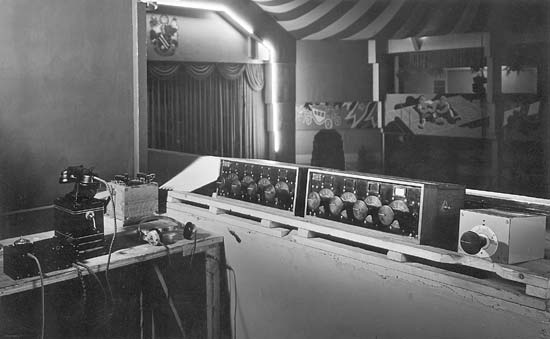

Public address to the large audience in the theatre was provided from two large Voigt horn loudspeakers suspended from the roof of the hall and located just above the proscenium arch. To service these loudspeakers, adjust the polarity of the polarising voltage of 200 v. and check operation at each performance, a walkway was provided consisting of wooden slats laid on two wires stretched between the walls of the National Hall (photo, right). There were no hand rails or solid support and access to the walkway was by climbing up the back of the proscenium arch. The 200v. was on open brass terminals, too, and easily touched! (No safety at work regulations in those days!)
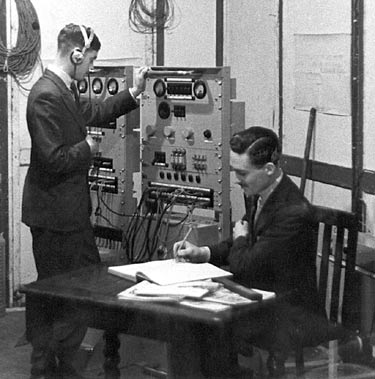
The equipment in the theatre control room consisted of
two 5 ft bays which provided incoming and outgoing amplifiers with fusing
and metering facilities and line terminating items for lines to BH, to the
main hall sound distributing system and to the output of the stage cubicle.


Batteries (right) supplied power to this equipment. The audio signal to the two P.A. speakers was provided from an amplifier with a spare unit mounted in a wheeled "pram". This operated from the 230v mains. A main volume control was placed amongst the audience and operated by an engineer at every

I believe that all this equipment was made solely for use at the Radio Exhibition and had no connection with normal Outside Broadcast equipment.
As I mentioned above, Mr. J. A. G. Mitchell was the senior BBC engineer for the project and generally looked after the distribution of sound to the stands whilst I was responsible for the theatre in 1936 & 1937. We were assisted by some university students. Some Balance & Control staff were responsible for operating the theatre mixing cubicle.
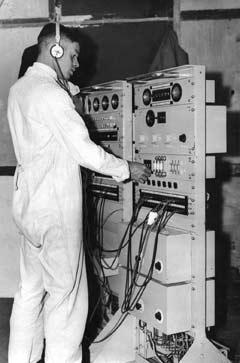
The theatre gave two or three performances a day for the fortnight of the show, featuring well known radio personalities, although there was a chorus line of girls to provide some visual entertainment. Acts included a performance on a Wurlitzer organ which was pushed forward from the rear of the stage instead of rising from the orchestra pit.
1936 saw the start of the Post Office's talking clock service and the first voice was that of Jane Cane - the girl with the golden voice. A P.O. telephone box was used on the stage and Jane provided one of the acts from that.
(left) The author at the bays in the Theatre Control Room.

